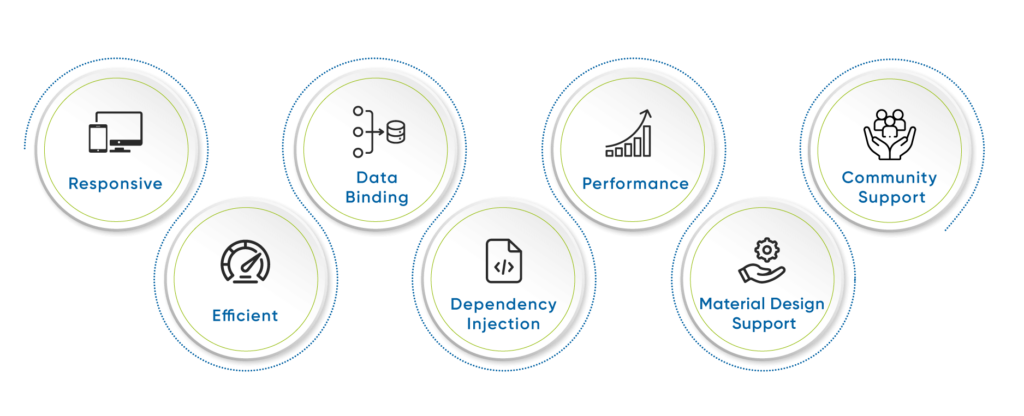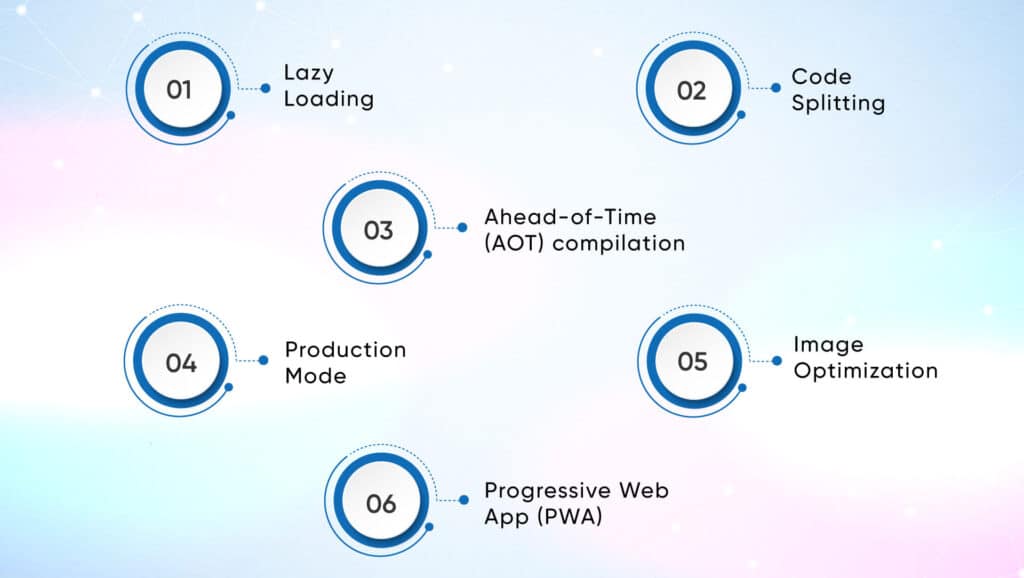5 Reasons To Use Angular For Web Development

Choosing the proper web development framework from multiple options can be challenging. In today’s rapidly evolving digital landscape, efficiency is crucial. This is where Angular stands out as the preferred choice for developers specializing in Angular development, seeking rapid development and optimal performance.
Angular provides developers with many tools and features to build robust and scalable web applications. Developers can use the Angular framework to reuse the components in their code. It also enables the application level configuration and handling the multiple profiles such as Development, QA, Pre-Prod, and Production Environment. This will increase the productivity of the developers. In Angular, developers can create engaging and adaptable web applications that meet the ever-changing needs of the digital landscape.
Developers might get the questions like “Angular is a framework or library?”, “Why should we choose Angular over other frameworks?”, “What is angular development”? And “What is angular in web development?”. Let’s find answers to these questions.
What is Angular?
Angular is an open-source Framework, not a library developed by Google for web application development. Angular uses TypeScript, an enhanced version of JavaScript, to streamline and enhance the angular web application development process.
Using the Angular web framework, developers can create dynamic and responsive web applications without facing performance issues. Also, the Angular framework has several tools and resources that help developers build scalable applications and meet business requirements.
Why use Angular for Web Development?

Angular is a preferred choice for web development because it offers multiple benefits. Below are some reasons to choose Angular for web development:
- Responsive: Angular framework can work with different devices and screen sizes. Developers can create a web application that supports mobiles, iPads, and desktop screens without changing the user interface.
- Efficient: Angular Framework supports Typescript, which helps developers write clean and reusable code. This certainly helps to speed the angular software development.
- Data Binding: Angular has built-in two-way data binding, automatically synchronizing data between the component and the user interface. This saves time and increases productivity.
- Dependency Injection: Angular Framework has a dependency injection mechanism that helps write code available at the application level.
- Performance: Angular web Framework is a single-page application framework. It provides performance optimization using Ahead-of-Time (AOT) compilation and lazy loading, which improve the page load times and rendering speed of the HTML page.
- Material Design Support: Angular offers Material libraries with ready-to-use UI components, making creating visually appealing and consistent user interfaces more accessible.
- Community Support: Angular has a large and active community that provides comprehensive documentation and support. Developers can also post their questions and get quick responses from the community, which helps them speed up the development process.
Below are the Reasons To Choose Angular For Your Web Development Project:
Simplified MVC Architecture:
The Angular Framework is built on the Model-View-Controller (MVC) architecture, providing a structured and organized approach to developing an angular website. It separates the application logic into three components: the model, the view, and the controller.
In the Angular MVC architecture, the model layer represents the data required to write the business logic in the application. It handles data parameters and facilitates communication between different components. Conversely, the view is responsible for rendering the user interface and displaying the data to the users. The controller layer is responsible for managing the data flow of the application and interactions between the model layer and the view layer.
Using the Angular MVC architecture, developers can separate the code into the Model Layer, View Layer, and Controller for better code reusability. This approach not only speeds up Angular development, but also improves code reusability, and increases productivity.
Overall, the Angular Framework MVC architecture offers a structured way to create the web application. It offers code organization, enhances data management, and provides code reusability features, making it a preferred choice for building scalable Angular web applications.
Two-Way Data Binding
Angular web Framework provides a two-way data binding feature, automatically synchronizing data between the component and the template. This eliminates the need for manual updates, increasing productivity and improving the user experience.
Angular has the ngModel directive that provides property binding and event binding, which helps to achieve two-way data binding. Using the [(ngModel)] syntax with input elements ensures bidirectional data flow, instantly updating the component’s or the template’s changes.
Furthermore, Angular’s Forms module in angular software development enhances data management with data validation and control state management features. It abstracts away the underlying logic and provides a simple syntax, making it easier to implement two-way data binding.
Fast Loading

To ensure fast loading in Angular, optimizing the loading time of your application is crucial for a seamless user experience.
By implementing the following techniques, you can improve the loading speed:
- Lazy loading: Lazy loading loads the modules and the components on demand, reducing the initial bundle size and increasing the page loading speed by only fetching the necessary resources when needed.
- Code splitting: In Angular, Developers can divide the code into smaller chunks. It helps to load the components separately. This approach improves initial load times by loading essential components first and deferring the loading of non-essential ones.
- Ahead-of-Time (AOT) compilation: Compile templates and components during the build process, resulting in smaller bundle sizes and faster rendering in the browser.
- Production mode: Enable production mode in Angular to optimize your application for performance. This mode reduces JavaScript bundle sizes by eliminating development-specific features and enabling advanced optimizations. By using tools like UglifyJS and Terser, we can compress the application code to improve the loading speed.
- Image optimization: Optimize your images during the build process using tools like Image in or Angular plugins. These tools reduce the file sizes of images without compromising quality, resulting in faster loading times.
- Progressive Web App (PWA): Convert your Angular app into a Progressive Web App to leverage features like offline functionality, caching, and improved performance. PWAs ensure your application remains accessible and performs well, even in low or no network conditions.
Faster Development
A responsive and user-friendly User Interface (UI) is essential for web and mobile applications.
However, developing a responsive User Interface from scratch in Angular takes time and effort. To speed up development, external User Interface component libraries are available for the Angular Framework. Some popular options include:
- Ngx-bootstrap: Integrates Bootstrap components with Angular, providing a responsive UI and improved performance.
- Teradata Covalent: A comprehensive Angular and Angular Material-based web framework for creating modern and consistent UI.
- Angular Material: The official component library for Angular, offering reusable and well-tested UI components.
- Ng-bootstrap: Bootstrap is a widely-used Angular CSS framework. Angular-specific widgets built using Bootstrap 4 CSS, offering a mature and stable solution for production ready.
- Onsen UI: A framework for developing hybrid mobile apps with Angular, offering platform-specific directives.
- MDB: Built with Angular, Bootstrap 4, and TypeScript, providing various material UI elements and icons.
- NG-LIGHTNING: Native Angular components and directives for Salesforce’s Lightning Design System.
- Semantic UI: A popular UI component library with semantics built on Angular 2.
- Clarity Design System: An open-source design system combining UX guidelines, HTML/CSS framework, and Angular components.
- Ignite UI: It Provides Material based Angular UI components optimized for high performance and handling large volumes of data.
The Nrwl Extensions (Nx) support also provides an open-source build system that enhances developer productivity and ensures code quality. Nx facilitates the generation of Angular applications within the Nx workspace, addressing code sharing and consistency challenges in multiple Angular projects. It loads only the application’s necessary components during the build process, which helps improve build creation time. Nx also offers mono and non-mono repo approaches, providing code organization solutions for different project structures. Other popular UI component libraries for Angular development include Kendo UI, Vaadin, Amexio, DevExtreme, Wijmo, and jQwidgets. These libraries offer ready-to-use UI components, saving development time and ensuring a consistent and visually appealing user interface.
Strong Community Support
The Angular framework benefits from a solid and active community support system, which is essential for Angular web development. This support system includes comprehensive documentation, online forums, and communities where developers can find helpful information and solutions. Using the Angular Command Line (CLI) tool, we can also create the components, services, structure, and many more things, simplifying and speeding up Angular web development.
The Angular community provides a wide range of learning resources, including tutorials, blogs, videos, and online courses, that equip developers with extensive knowledge and support their growth in the Angular ecosystem. Their valuable contributions and feedback shape the future of Angular, driving its continuous improvement.
Angular has a responsive nature, efficiency, data binding, performance optimization, community support, and Material Design capabilities, making it the right choice for angular web app development. It enables developers to build responsive web applications efficiently.
Conclusion
Angular is a popular and widely used framework for angular web applications. It provides extensive library support, responsive design capabilities, and a modular architecture that promotes code reusability. It offers fast development and productivity through TypeScript and optimizes performance through ahead-of-time compilation. The active community support also adds to its appeal, making Angular the right choice for angular web application development.
Frequently Asked Questions
There are several advantages of using Angular Framework, which include:
- Angular offers a modular architecture that enhances code maintainability, reusability, and scalability.
- Angular has a Two-way data binding feature, simplifying development, improving productivity, and updating the data between the user interface and data model.
- Angular provides features like dependency injection, declarative templates, and a powerful CLI, improving productivity and facilitating rapid application development.
- To improve application loading time, Angular provides performance optimization techniques such as AOT compilation, lazy loading, and tree shaking.
- Angular enables cross-platform development, allowing applications to run seamlessly on web browsers, mobile devices, and desktops.
- Angular benefits from strong community support, providing extensive documentation, online forums, and resources for continuous improvement and learning opportunities.
In the Angular framework, developers can transfer the data between parent and child components using two-way data binding. It also supports the MVC architecture, which makes the application structured. Additionally, it has dependency injection and a caching mechanism to improve the application’s speed and reduce the application’s page loading time. These features differentiate it from other web applications and make it a better choice for web development.
The Angular Framework offers multiple benefits, including code reusability through component management. It supports responsive libraries like Bootstrap and Material UI, speeding development. It can transfer data between parent and child components. Additionally, it benefits from strong community support, helping developers resolve any development-related issues.
Angular is a framework, and HTML is a template used to create websites. In addition Angular offers a modular architecture, two-way data binding, and performance optimizations, resulting in consistent and reusable code, faster loading times, and increased flexibility for web development.
Yes, an Angular developer is a web developer in Angular web development. Angular is a framework that includes HTML pages, CSS, images, and other resources used to design for web development. Angular can design the website, so Angular developers are web developers.




